Academy 1/48th P-38F Lightning “Glacier Girl”By Gerry Nilles |
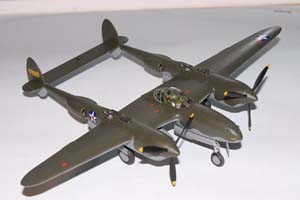 |
Introduction :
The history of the P-38 Lighting is well documented to say the least. Known by the enemy as the “Forked Tailed Devil”, in both the European and Pacific theaters, the P-38 was the brainchild of the young and brilliant Lockheed Aircraft Company designer Kelly Johnson. Interestingly the P-38 was the first all military aircraft to be design and build by Lockheed. Also of interest is the fact that the P-38 was produced in fewer numbers than any other major contemporary WWII U.S.A.A.F. fighter aircraft. Less than 10,000 had been built when production ended in August 1945.
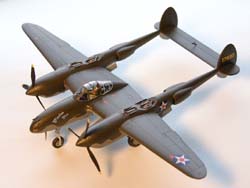 The
first P-38 to be produced in any significant quantities was the “E”
model of which 210 were built. However the P-38F was the first version
that truly obtained, what could be considered, full operational status.
The “F” model, of which 527 were delivered, began to appear
in mid 1942. The main difference from its predecessor was the use of more
powerful V-1710-49/52 Allison engines as well as the more visually obvious
addition of a hard point/pylon on each inner wing. These hard points allowed
the “F” to carry either ordinance and/or more importantly
external fuel tanks that significantly extended its range. This extended
range became a key factor when it came to deployment to the British Isles.
The
first P-38 to be produced in any significant quantities was the “E”
model of which 210 were built. However the P-38F was the first version
that truly obtained, what could be considered, full operational status.
The “F” model, of which 527 were delivered, began to appear
in mid 1942. The main difference from its predecessor was the use of more
powerful V-1710-49/52 Allison engines as well as the more visually obvious
addition of a hard point/pylon on each inner wing. These hard points allowed
the “F” to carry either ordinance and/or more importantly
external fuel tanks that significantly extended its range. This extended
range became a key factor when it came to deployment to the British Isles.
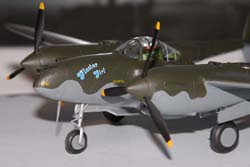 Due
to its design the Lightning took up a considerable amount of area. If
shipped in quantity it would have used up much needed cargo space that
could have been allotted to other essential war supplies. Also considering
shipping loses to German U-boats at that time, P-38s ending up at the
bottom of the Atlantic probably would have been significant. However,
being the first fighter able to make the crossing in the air this didn’t
become a problem. So in the summer of 1942 the 1st and 14th Fighter Groups
began to transition to the United Kingdom by pioneering what was called
the North Atlantic route. This trip consisted of first flying from the
U.S to Labrador, Greenland, Iceland and then on to Scotland and England.
The P-38 squadrons making the trip flew in formation with several B-17s
that provided navigation. During that first summer a total of 179 out
of 186 P-38s successfully flew this route.
Due
to its design the Lightning took up a considerable amount of area. If
shipped in quantity it would have used up much needed cargo space that
could have been allotted to other essential war supplies. Also considering
shipping loses to German U-boats at that time, P-38s ending up at the
bottom of the Atlantic probably would have been significant. However,
being the first fighter able to make the crossing in the air this didn’t
become a problem. So in the summer of 1942 the 1st and 14th Fighter Groups
began to transition to the United Kingdom by pioneering what was called
the North Atlantic route. This trip consisted of first flying from the
U.S to Labrador, Greenland, Iceland and then on to Scotland and England.
The P-38 squadrons making the trip flew in formation with several B-17s
that provided navigation. During that first summer a total of 179 out
of 186 P-38s successfully flew this route.
Lost Squadron:
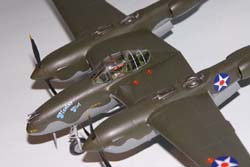 As
I noted above during the summer months of 1942 a total of 179 Lockheed
built fighters successfully transitioned from the U.S. to England via
the North Atlantic Route. However seven didn’t make it, and not
surprisingly information concerning such missing aircraft usually is more
compelling. The stories surrounding “Lost Squadrons” seems
to take on a mystical quality and as such conjures up any number of scenarios
as to their fate. However, in the case of six of those seven lost Lightings
there wasn’t anything mystical or even tragic about their fate,
but their story is definitely more interesting.
As
I noted above during the summer months of 1942 a total of 179 Lockheed
built fighters successfully transitioned from the U.S. to England via
the North Atlantic Route. However seven didn’t make it, and not
surprisingly information concerning such missing aircraft usually is more
compelling. The stories surrounding “Lost Squadrons” seems
to take on a mystical quality and as such conjures up any number of scenarios
as to their fate. However, in the case of six of those seven lost Lightings
there wasn’t anything mystical or even tragic about their fate,
but their story is definitely more interesting.
The date was July 15th 1942. A group of six, factory fresh, P-38Fs and two B-17 navigational aircraft departed the West Coast of Greenland on the next leg of their trip east. Just prior to reaching Iceland the group ran into a massive storm. Their attempts to get above it almost ended in tragedy because of a combination of wing icing as well as pilot and crew hypothermia. As a result they decided to return to Greenland. As fate would have it the bad weather had also closed in behind them. Their luck however had not completely run out, and they did manage to break through the cloud cover over the Greenland ice cap. They were able to reestablish their position, only to determine that they didn’t have enough fuel to make it back to the base. At this point the group decided that their one chance of survival was to put down on the glacier. A flyby was done and gave the impression that the surface was smooth as well as reasonably flat and hard. 1st. Lt. Brad McManus made the initial landing attempt wheels down. As it turned out the glacier was covered with a layer of soft snow and upon landing the P-38 flipped over. Fortunately Lt. McManus sustained only minor injuries. The rest of the group then proceeded to successfully do wheels up crash landings. Amazingly, there were no significant injuries to any of the 28 men aboard the eight aircraft involved. To this day, it is still the largest forced landing in Air Force history.
Rescue, Recovery, & Restoration:
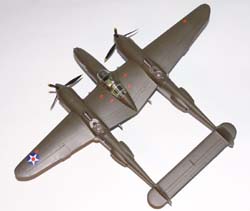 Rescue
of the stranded aviators occurred eleven days later. Their location, that
was about ten miles below the Arctic Circle, was definitely remote. A
rescue mission, of five U.S. Army Personnel, from the Angmagssalik Greenland
weather station, finally reached them on July 26th. At this point, the
aircraft were abandoned and the group safely returned to the weather station
for transport back to their units.
Rescue
of the stranded aviators occurred eleven days later. Their location, that
was about ten miles below the Arctic Circle, was definitely remote. A
rescue mission, of five U.S. Army Personnel, from the Angmagssalik Greenland
weather station, finally reached them on July 26th. At this point, the
aircraft were abandoned and the group safely returned to the weather station
for transport back to their units.
After the first winter, following the forced landings, the aircraft were never seen on the surface of the ice again. However, they certainly were not forgotten, and during the post WWII years a total of thirteen expeditions were mounted to try and relocate and recover them. Success finally came in the summer of 1992 after ten years of effort by one recovery group. As it turned out locating any of the lost squadron was a monumental task that required very specialized equipment. During the half-century, since they were abandon, it is estimated that the aircraft had moved over a mile from their original location because of glacier drift. But more surprisingly was the fact that the one P-38, they did locate, was now buried almost 270 feet below the surface. Imagine the problems of having to go down through solid ice the height of a 27story building. But, that is exactly what this determined recovery team did. Finally on August 1st 1992, after four month of supreme effort and the use of unique equipment to melt a four-foot diameter hole 268 feet down through the glacier, the P-38 was reached. The weight and pressure of the glacier ice had taken its toll on the plane, but it was all there.
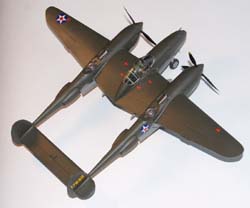 Restoration,
of the P-38F, now appropriately named “Glacier Girl” took
another ten years as well as a major financial commitment. Although new
at the time of the forced landing, much of the aircraft had been flattened
and stressed because of the pressures of the ice. Determined to use as
much of the original as possible, work began. In the end approximately
80% of the aircraft was either repaired or refurbished. Actually locating
the balance of the now fifty plus year old, parts became the real challenge
not to mention the expensive. But perseverance and dedication eventually
paid off and on October 26th 2002 one of the most perfect war bird restoration
ever accomplished, flew again. Today “Glacier Girl” can be
seen at the Middlesboro KY. Museum, that is located at the Middlesboro
airport. For more information on “Glacier Girl” visit www.thelostsquadron.com.
Restoration,
of the P-38F, now appropriately named “Glacier Girl” took
another ten years as well as a major financial commitment. Although new
at the time of the forced landing, much of the aircraft had been flattened
and stressed because of the pressures of the ice. Determined to use as
much of the original as possible, work began. In the end approximately
80% of the aircraft was either repaired or refurbished. Actually locating
the balance of the now fifty plus year old, parts became the real challenge
not to mention the expensive. But perseverance and dedication eventually
paid off and on October 26th 2002 one of the most perfect war bird restoration
ever accomplished, flew again. Today “Glacier Girl” can be
seen at the Middlesboro KY. Museum, that is located at the Middlesboro
airport. For more information on “Glacier Girl” visit www.thelostsquadron.com.
The Kit:
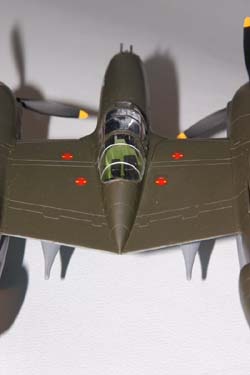 First
I want to note that the Academy 1/48th scale P-38F “Glacier Girl”
is a re-release of their P-38E kit that was previously issued in 1994.
It also should be noted that Academy has released a number of 1/48th scale
P-38 variants over the years. The reason I point this out is because the
trees in “Glacier Girl” include parts for other P-38 variants,
and as such care should be taken so that they are not mistakenly use on
this kit. Make sure you review the instructions and part numbers carefully
to avoid confusion.
First
I want to note that the Academy 1/48th scale P-38F “Glacier Girl”
is a re-release of their P-38E kit that was previously issued in 1994.
It also should be noted that Academy has released a number of 1/48th scale
P-38 variants over the years. The reason I point this out is because the
trees in “Glacier Girl” include parts for other P-38 variants,
and as such care should be taken so that they are not mistakenly use on
this kit. Make sure you review the instructions and part numbers carefully
to avoid confusion.
The kit contains ten trees, including eight for the airframe assembly that are molded in light gray plastic, one for the clear parts, and one in black PVC for the tires. Sink marks are very minor if you find any at all. Construction is very straightforward starting with the cockpit assembly. Again make sure you are using the correct parts in that an early and late style radio deck, pilots control wheel and instrument hood are provided. Also extra care should be taken when removing the control wheel from the tree in that is very finely cast and fragile.
As a side note, I made several modifications/corrections to the basic kit at step #4. The first had to do with the instrument hood/panel piece (F14). According to every photo I have seen of early operational P-38 cockpits, there is no hood covering the instrument panel. There is a thin lip around the upper edge of the panel, but that’s all. As a result I cut away most of the hood leaving that thin edge out from the area needed for the windscreen to rest on. Make sure to save the gun site that is attached to the back edge of the hood.
 Next,
using the instrument panel decal (B) as a pattern, I cut out a backing
plate of thin styrene card. This plate extends down from the lip to rest
on the top of the switch box (E9). Once the backing plate was cemented
in place to piece (F14) I painted it flat Black and added it to the fuselage
assembly. I then attached the instrument panel decal to the backing plate.
It is a snug fit but it works. The last thing I did was to reattach the
gun site to the lip just blow the windscreen.
Next,
using the instrument panel decal (B) as a pattern, I cut out a backing
plate of thin styrene card. This plate extends down from the lip to rest
on the top of the switch box (E9). Once the backing plate was cemented
in place to piece (F14) I painted it flat Black and added it to the fuselage
assembly. I then attached the instrument panel decal to the backing plate.
It is a snug fit but it works. The last thing I did was to reattach the
gun site to the lip just blow the windscreen.
The second mod I made was to drill out the radiator intakes on parts (D22) and (D23). In order to give them a little more depth and a finished look I added short pieces of Evergreen 3/16” tubing to the backside of the intakes (about 1/8th of and inch long) and then covered the tube ends with some fine brass screen.
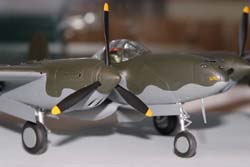 After
that I found the rest of the assembly be fairly logical and easy to follow.
I did encounter a few areas where the fit is not that great especially
where the engine booms attach to the wing. But with some filling and a
little careful work including some re-scribing of panel lines they came
out pretty good.
After
that I found the rest of the assembly be fairly logical and easy to follow.
I did encounter a few areas where the fit is not that great especially
where the engine booms attach to the wing. But with some filling and a
little careful work including some re-scribing of panel lines they came
out pretty good.
The only other thing that I might mention has to do with the PVC tires. First, sometimes styrene has been known to slowly dissolve when it comes in direct contact with certain kinds of PVC. Now this might not be a problem with this kit but just to be safe I made sure that all surfaces of the wheel rims were completely painted prior to mounting the tires. Also, when comes to time to mount the tires I always warm them up with a hair dryer first. This makes them much more pliable and a lot easier to get onto the wheel rims.
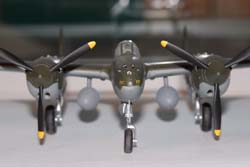 Speaking
of painting I finished the model using Testors Model Masters enamels.
On the underside I used flat Neutral Gray (FS36270) while the top was
painted with flat Green Drab FS 34086. The reason I used Green Drab instead
of Model Masters Olive Drab FS 34087 is because the Green Drab is a very
close match to factory fresh Dark Olive Drab 41 as was the case with the
“Glacier Girl” aircraft. If I had done the other scheme I
would have probably have used Model Master Faded O/D considering this
aircraft operated in the tropics and obviously had been in service for
a while.
Speaking
of painting I finished the model using Testors Model Masters enamels.
On the underside I used flat Neutral Gray (FS36270) while the top was
painted with flat Green Drab FS 34086. The reason I used Green Drab instead
of Model Masters Olive Drab FS 34087 is because the Green Drab is a very
close match to factory fresh Dark Olive Drab 41 as was the case with the
“Glacier Girl” aircraft. If I had done the other scheme I
would have probably have used Model Master Faded O/D considering this
aircraft operated in the tropics and obviously had been in service for
a while.
Decals:
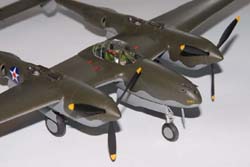 The
kit comes with markings for two P-38Fs. The first set is of course for
“Glacier Girl” as it look today. The second is an early PTO
bird from the 339FS/347FG named “Oriole” that was flown by
Capt. Murray J. Shubin. The 339FS is probably best known as the squadron
that downed Admiral Yamamoto. Also included on the sheet is every stencil
that I think was ever used on a P-38. Typical of Academy the decals are
of good quality and registration.
The
kit comes with markings for two P-38Fs. The first set is of course for
“Glacier Girl” as it look today. The second is an early PTO
bird from the 339FS/347FG named “Oriole” that was flown by
Capt. Murray J. Shubin. The 339FS is probably best known as the squadron
that downed Admiral Yamamoto. Also included on the sheet is every stencil
that I think was ever used on a P-38. Typical of Academy the decals are
of good quality and registration.
Conclusion:
This Academy re-released may be slightly dated and although it has a few fit problems it is still nicely done and definitely makes into a very decent P-38F.
Many thanks to Academy for supplying this sample kit.